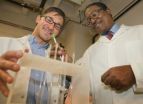(Press-News.org) STANFORD, Calif. — A genetic marker touted as a predictor of coronary artery disease is no such thing, according to a study led by researchers at the Stanford University School of Medicine.
The massive international study, published online Oct. 7 in the Journal of the American College of Cardiology, assessed the predictive value of a leading genetic assay for risk of atherosclerosis.
The study analyzed the data from more than 17,000 patients with cardiovascular disease and 40,000 others to assess whether carrying a particular variant of the KIF6 gene indicated a greater risk for coronary artery disease — a disease characterized by a buildup of cholesterol plaque in the walls of the arteries of the heart. The disease can lead to chest pain as well as heart attacks, which are often fatal.
The study found essentially no association between the gene variant and the risk of coronary disease. "This study puts the nail in the coffin," said Tom Quertermous, MD, the William G. Irwin Professor in Cardiovascular Medicine at Stanford and the study's senior author. "This is such a big study — if there was a significant association between this variant and coronary disease, we would have found it."
Celera Corp., which pioneered the mapping of the human genome, owns the assay and currently performs the majority of the testing services. In June, as part of its effort to make the assay more widely available, Celera announced it had received approval from the European Union to market a test kit for the variant that would make it easier for physicians to collect patients' samples. The company said it would also submit an application to the U.S. Food and Drug Administration this year for approval of the test kit.
Previous studies of the variant were less conclusive because they were based on fewer patients with coronary artery disease, said the new study's leader, assistant professor of medicine Themistocles Assimes, MD, PhD. These earlier studies had suggested a 22-55 percent greater risk for those who had the variant. "We are showing that the additional risk is almost certainly nil in subjects of European ancestry. If it is not nil, it is at most 2 percent," Assimes said.
The study pulled together data from research groups around the world that have genetically fingerprinted individuals with known coronary disease as well as subjects with no known disease. Most of the data were from people of European descent, but a lack of association was also noted in smaller number of subjects of non-European ancestry. The Stanford researchers' co-authors include more than 130 scientists, clinicians and administrators at over 70 research organizations in Europe and North America.
The study offers good news to patients whose KIF6 test result had indicated they were at risk for heart attacks. "They don't need to worry so much," Quertermous said. "If they are on medications strictly because of their KIF6 test result, they should ask their doctor to reconsider the need for these medications."
Because of the study's design, it could not directly confirm or refute the marker's ability to identify the subjects' response to statins, which are drugs that lower cholesterol levels. However, Assimes cautioned that the original observation, which found the KIF6 variant indicated a good response to the medication, assumed that carriers of the variant not on statins were at significantly increased risk of coronary disease compared to non-carriers.
"In light of our findings, the marker's ability to identify statin responders is also in doubt," said Assimes. "Until very large-scale studies are performed to directly test the marker's ability to identify statin responders, I would not withhold statins from patients just because their KIF6 test was negative."
The finding's larger message is that more caution is warranted when using genetic markers to guide health care. There's understandably great desire to use the information about human genetics that's been amassing since the sequencing of the human genome 10 years ago, said Quertermous, who has worked in the field for more than 20 years. "It's something I've been waiting for, for a long time."
That's because the well-known risk factors for atherosclerosis, such as high cholesterol, smoking, diabetes and high blood pressure, appear to account for only about half the variation of rates of coronary disease observed in human populations. The balance of variation is likely explained by a combination of inherited variants in or near genes that are important in the pathogenesis of disease in addition to other unrecognized, adverse environmental exposures.
"Using genetics to help improve our ability to predict coronary disease is particularly important because we have several different classes of drugs at our disposal that can substantially reduce the risk of heart attacks" said Assimes. "But we still need to be careful about what we put into practice and not get carried away too quickly. We know from previous experience that a positive association between a genetic variant and a common disease, such as coronary disease, needs to be consistently observed in many human population studies before it can be believed."
In fact, Quertermous points out that even for the roughly one dozen genetic markers that have been successfully validated to date, evidence to support their use in clinical practice is lacking. However, this situation will likely change in the near future as researchers reliably identify more genetic markers.
The data collections used in this study were supported by more than 30 institutions including government and nonprofit agencies and the following companies: Astra Zeneca, Berlin Chemie, Boots Healthcare, deCODE genetics, Glaxo-Smith-Kline, McNeil Pharma (former Woelm Pharma), MSD Sharp & Dohme and Pfizer.
INFORMATION:
Assimes and Quertermous have no financial ties to Celera or competing companies. Among the other study contributors are four employees of the company deCODE genetics, which offers another cardiovascular genetic test, which is licensed to Celera. None of the study's authors were employees of Celera.
Information about the Department of Medicine, which also supported the work, is available online at http://medicine.stanford.edu.
The Stanford University School of Medicine consistently ranks among the nation's top medical schools, integrating research, medical education, patient care and community service. For more news about the school, please visit http://mednews.stanford.edu. The medical school is part of Stanford Medicine, which includes Stanford Hospital & Clinics and Lucile Packard Children's Hospital. For information about all three, please visit http://stanfordmedicine.org/about/news.html.
Stanford-led study disproves link between genetic variant, risk of coronary artery disease
2010-10-08
ELSE PRESS RELEASES FROM THIS DATE:
New tool in the fight against tuberculosis
2010-10-08
Researchers at the Institute for Genomic Biology at the University of Illinois have developed a way to harness the prodigious quantities of both genomic and metabolic data being generated with high-throughput genomics and other techniques. They have developed an algorithm that automatically integrates both data sets. The model, called probabilistic regulation of metabolism (PROM), enables researchers to perturb a given regulatory gene or metabolic process and see how that affects the entire network.
"PROM provides a platform for studying the behavior of networks in a ...
Thoughts about time inspire people to socialize
2010-10-08
Does thinking about time or money make you happier? A new study published in Psychological Science, a journal of the Association for Psychological Science, finds that people who are made to think about time plan to spend more of their time with the people in their lives while people who think about money fill their schedules with work, work, and—you guessed it—more work.
To find out how thinking about time or money makes people feel, Cassie Mogilner of the University of Pennsylvania designed an experiment, carried out online with adults from all over the United States, ...
Brown University chemists simplify biodiesel conversion
2010-10-08
PROVIDENCE, R.I. [Brown University] — As the United States seeks to lessen its reliance on foreign oil, biodiesel is expected to play a role. According to the National Renewable Energy Laboratory, a branch of the Department of Energy, biodiesel "represents a significant energy resource and could someday supply 3 percent to 5 percent of the distillate fuel market."
One major obstacle to achieving that goal is figuring how to efficiently convert the abundant stocks of waste vegetable oil (oil used after cooking French fries, for example) into biodiesel fuel. Current techniques ...
Melanoma uses body's immune system to spread to lungs
2010-10-08
The way melanoma cells use the immune system to spread and develop into lung tumors may lead to a therapy to decrease development of these tumors, according to Penn State researchers.
"Melanoma is the most aggressive and metastatic form of skin cancer," said Gavin Robertson, professor of pharmacology, pathology, dermatology and surgery in the Penn State College of Medicine. "Therefore, identifying proteins and molecular mechanisms that regulate metastasis is important for developing drugs to treat this disease."
Metastasis is a complex process in which cancer cells ...
MIT researchers develop a better way to see molecules at work in living brain cells
2010-10-08
CAMBRIDGE, Mass. -- By creating a better way to see molecules at work in living brain cells, researchers affiliated with MIT's Picower Institute for Learning and Memory and the MIT Department of Chemistry are helping elucidate molecular mechanisms of synapse formation. These studies could also help further understanding of how synapses go awry in developmental diseases such as autism and Fragile X syndrome. The study will appear in the Oct. 7 issue of Cell.
Using the new technique, which is more accurate and sensitive than existing methods, the researchers found that ...
US invested $139 billion in health research in 2009
2010-10-08
WASHINGTON—October 7, 2010—The U.S. invested $139 billion last year in health research from all public and private sources, according to Research!America's latest annual estimate. That amount represents only 5.6% of the $2.47 trillion overall U.S. health spending in 2009—or 5.6¢ of every health dollar—which varies no more than 0.2% from 2005 levels.
The estimate is available here: http://www.researchamerica.org/uploads/healthdollar09.pdf.
The 2009 investment grew by only 0.1% over 2008. This small increase can be attributed largely to the federal stimulus funding ...
NASA satellites see Otto become a tropical storm
2010-10-08
NASA satellites have collected data as the Atlantic Ocean's Tropical Depression 17 has undergone two changes in less than 24 hours. Since Oct. 6, the depression has strengthened and has tropical storm-force winds and has morphed from a sub-tropical storm into a tropical storm.
After a United States Air Force Reserve reconnaissance flight subtropical depression seventeen was upgraded by the National Hurricane Center (NHC) to subtropical storm Otto on Oct. 6 at 5 p.m. EDT (2100 UTC). On Oct. 6 and 7, NASA's TRMM and Aqua satellites were flying overhead measuring very cold, ...
Saturn's icy moon may keep oceans liquid with wobble
2010-10-08
Saturn's icy moon Enceladus should not be one of the most promising places in our solar system to look for extraterrestrial life. Instead, it should have frozen solid billions of years ago. Located in the frigid outer solar system, it's too far from the sun to have oceans of liquid water -- a necessary ingredient for known forms of life -- on its surface.
Some worlds, like Mars or Jupiter's moon Europa, give hints that they might harbor liquid water beneath their surfaces. Mars is about 4,200 miles across and Europa almost 2,000 miles across. However, with a diameter ...
3-way control of fetal heart-cell proliferation could help regenerate cardiac cells
2010-10-08
PHILADELPHIA - Heart muscle cells do not normally replicate in adult tissue, but multiply with abandoned during development. This is why the loss of heart muscle after a heart attack is so dire—you can't grow enough new heart muscle to make up for the loss.
A team of researchers at the University of Pennsylvania School of Medicine describe the interconnections between three-molecules that control fetal, heart-muscle-cell proliferation in a mouse model that will help cardiologists better understand the natural repair process after heart attacks and help scientists learn ...
Can you analyze me now? Cell phones bring spectroscopy to the classroom
2010-10-08
CHAMPAIGN, Ill. — University of Illinois chemistry professor Alexander Scheeline wants to see high school students using their cell phones in class. Not for texting or surfing the Web, but as an analytical chemistry instrument.
Scheeline developed a method using a few basic, inexpensive supplies and a digital camera to build a spectrometer, an important basic chemistry instrument. Spectrophotometry is one of the most widely used means for identifying and quantifying materials in both physical and biological sciences.
"If we want to measure the amount of protein in ...




